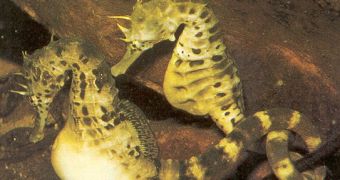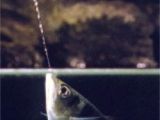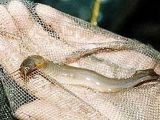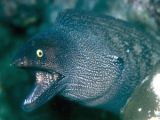Most people think that fish are some quite dumb beings living in the water, just waiting to be eaten. Is that really so? Read on and you may be amazed...
1. Archerfishes (Toxotes sp) reunite a group of seven small fish species, with a maximum length of 40 cm, found in fresh, brackish or marine waters from India to the Philippines, Australia and Polynesia.
They are unique in the animal kingdom because of their peculiar way of hunting for insects and other small terrestrial animals from branches hanging above the water by firing with great accuracy streams of water into the air to their prey, knocking down animals as big as small lizards onto the water's surface. Once fallen into the water, the fish dashes and gulps its prey.
The fish's "riffle" is formed by a groove on the mouth roof. When the tongue closes to the mouth roof, the groove turns into a pipe with a caliber of 1.5 mm. The fish contracts its gills and under the formed pressure, the water gushes towards the future victim. The fish can shoot up to 4 m (13 ft), but it is more precise up to 60 cm (2 ft).
Archerfish automatically calibrate the force they use to knock down prey according to prey size. The fish even knows where the insect will fall, waiting it there, and all is done in 0.1 seconds.
Archerfish automatically calibrate the force they use to knock down prey according to prey size. The fish even knows where the insect will fall, waiting it there, and all is done in 0.1 seconds.
It appeared that the tuning aspect of the archerfish's hunting strategy is purely innate and it has nothing to do with learning. The archerfishes always calibrate their water sprays so that prey animals are hit with about ten times the force of their organs of animals of that size could hold on.
2. We all know that females produce eggs and males sperm. Females are mothers and males are fathers. This has been so ever since the beginning of times. The female takes care of the eggs and eventually of the offspring. But the males of seahorses, pipefishes, weedy and leafy sea dragons (Syngnathidae) are the sex carrying the pregnancy!
This is unique and extreme in the animal world. The females of these fishes insert their ovipositors (like syringes) into a brood pouch on the male's chest and lay their eggs and the male then fertilizes and incubates the eggs. The pregnancies lasts 2-3 weeks and the male's body feeds the embryos. When the time comes, the daddy gives birth to independent offspring. These fish are also a case rare of life monogamy pairing amongst fish species.
Other fish, frog and bird species can have male carrying for the eggs and offspring, but this is the only case when males are really pregnant in the whole animal world!
3. The most dreaded fish of the Amazon is not the terrible electric eel, or piranha but a fish not longer than 17 cm (7 inch) and just 4-6 mm wide.
The Vampire Catfish, Candir■ or Canero (Vandellia cirrhosa) is completely transparent, and impossible to see in clear water, not to mention the turbid water of the Amazon. Resting candiru is found buried in muddy bottoms. A fast, powerful swimmer, the fish has sharp teeth and backward-pointing spines on its gill's covers.
The candir■ is a parasite fish, attacking the gills of large fish. It enters into the gill cavities of other fish, erects the opercle spine to get stuck, and the host's blood enters its gut by the host's blood pressure. All it needs is just needle-like teeth to make an incision in an artery, without sucking/pumping mechanisms. The feeding last 30-145 seconds.
If a person in the water is naked, candiru can enter into one of his/her body orifices (the vagina, rectum, or even the penis-and deep into the urethra) and due to the opercle's spines protruding from the fish, it is almost impossible to remove the fish, except through surgery. The fish probably mistake the urea for water expelled from gills (fish also urinate through gills).
The fish tracks down its host by following a water scent to its source and urinating while bathing increases significantly its chance of entering in a human urethra. Indians bathe facing the current, decreasing candiru's chances of entering in the rectum, while penis or vagina are covered up with the hands.
Two local plants, the Jagua or Huito (Genipa americana) and the Buitach apple, whose mixed extract will kill and after that dislocate the fish. But often enough, the infection causes shock and death of the victim before the candir■ can be removed. Even if candir■'s attacks on humans are recorded, it is not proven that the fish can actually survive once inside the human organism.
4. Many tropical fish burrow during the dry season, breathing - through lungs, intestine membrane, labyrinths or other specialized organs - oxygen from the air, but they have an active life in the water. But the mangrove killifish (Kryptolebias marmoratus) of the western Atlantic, a tiny species weighing 0.1 g, inhabits trees when the water they usually live in is gone!
Hundreds of killifish enter in the rotting logs and branches of mangrove trees during drought conditions, lined up like beans in a pod inside the galleries made by insects. This fish normally lives in ephemeral pools around the roots of the mangrove trees.
The life in the trees decreases the possibilities of finding a mate, but the fish is able to reproduce on its own, since it is hermaphrodite, and the only known hermaphrodite vertebrate able of self-fertilization (the sperm produce by one individual fertilizes its own eggs).
5. Some fish species can live in waters whose temperatures would turn any other fish into fish soup.
Desert pupfish (Cyprinodon macularius) from southwestern US and northern Mexico can live in hot springs whose water can have the temperature of 49o C. Alcolapia grahami (related to Tilapia) lives in the Lakes Magadi and Nakuru in Kenya and Lake Natron in Tanzania. It can stand temperatures up to 43o C in Lake Magadi.
6. Salt Creek pupfish (Cyprinodon salinus) from Death Valley (California) can stand salinity similar to 80 % of the sea salinity. Any freshwater fish would die in those waters.
7. The upsidedown catfish (Synodontis batensoda and related species) from Africa are famous as being the only fish species known for naturally swim belly-up.
8. There are fish species adapted to live in caves. This fish are usually blind and transparent (depigmented). In the caves of Indiana and Kentucky lives the northern cavefish (Amblyopsis spelea) while Astyanax jordani from the Mexican caves is a relative of piranha.
9.Moray eels are ugly like hell. Over 200 species dwell in tropical seas worldwide, inhabiting holes in rocks and coral reefs. These eels can scare the hell out of novel scuba divers, as some can reach 10 feet (3 m) in length and display a grin filled by large sharp teeth. There's no reason, as this fish won't attack people as prey (but they will defend themselves).
Recently was discovered a peculiar feeding apparatus in moray eels: they have two sets of jaws! After grabbing prey in its toothed jaws, a second set of jaws found in the moray's throat reaches forward into the mouth and displaces the food to the esophagus for swallowing.
Most fish swallow the food by suction. When it reaches the food or prey, the fish rapidly increases the volume of its mouth cavity, sucking in water with the food. The water is expelled through the gills openings, the food is passed to the esophagus.
Some species overtaking prey with their mouth open or grab it in their jaws, but the majority have to employ suction to send the food from the mouth to the esophagus.
But moray eels, hunting in confined spaces, cannot rapidly expand their mouths to create suction and as a result they had to evolve another method. They first immobilize prey with their powerful, toothsome outer jaws and then the pharyngeal jaws, armed with large, curved teeth, moves forward and grabs it. In this moment, the outer jaws release the prey and the back jaws send it back to the esophagus, all this is a fraction of a second.
This is the only vertebrate having a second, mobile set of (pharyngeal) jaws. When resting, the pharyngeal jaws remain located behind the eel's skull, inside its throat and when in action, they will move almost the length of the animal's skull, but won't go beyond the outer jaws.
10.In tropical seas lives the suckerfish (Remora) (which grows up to 30-50 cm) that has on its head and back an adhesive disk, made by transformed dorsal. African and Papuan fishermen use this small fish to catch large fish and sea turtles. Naturally, this fish adheres to larger animals (including sharks, whales, manta ray, sea cows, turtles) and even small boats to get free rides, protection and food from the host's leftovers and feces. Remoras can even clean the host of parasites.
Remoras were bound by the tail, released into the water, and pulled when they attached to an animal.

 14 DAY TRIAL //
14 DAY TRIAL // 



